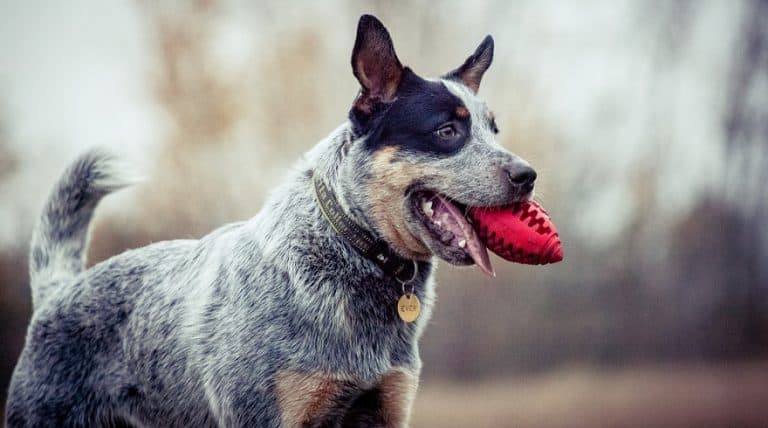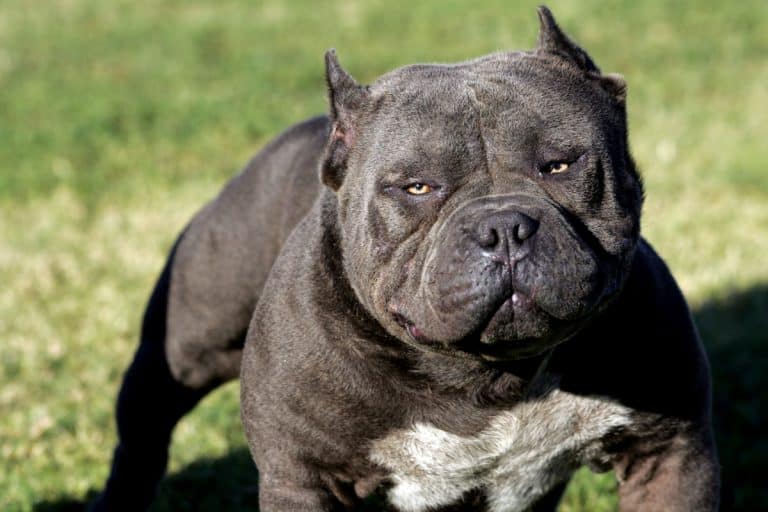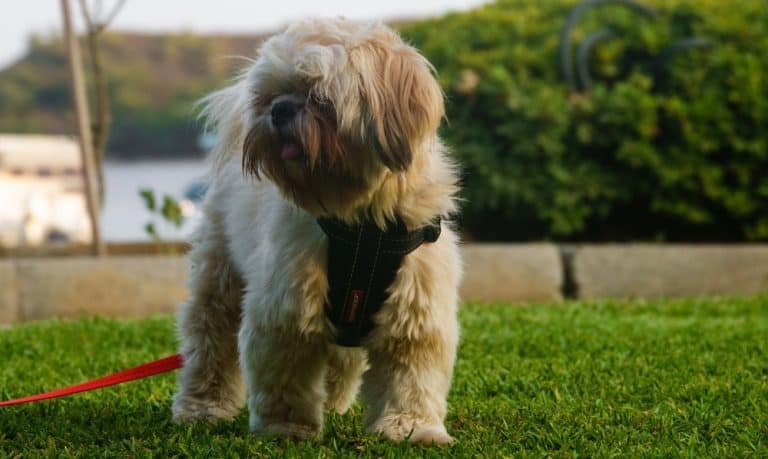Aussiedoodle Growth Chart – Weight & Size Chart
Sometimes referred to as an “Einstein” breed because of their high intelligence, the Aussiedoodle is a crossbreed of the poodle and Australian Shepherd. They are often referred to by many names including Aussiepoodle and Aussiepoo.
They are very playful, smart, and loyal, and have some of the best qualities from both of their parents.
Furthermore, they tend to do best in that can offer a lot of attention and exercise because if they become bored, they may act out in destructive ways. These qualities make the Aussiedoodle an excellent family dog.
Their coats come in a variety of colors usually seen in Australian Shepherds, such as red tri, red merle, blue merle, black and black and tan, parti, sable, or even a solid color in rare cases. Some Aussiedoodles have tighter curls like their Poodle parents while others have wavier coats.
Aussiedoodles with shorter hair may be better for allergy sufferers, but it is not a guarantee. As the potential or current owner of an Aussiedoodle, an Aussiedoodle growth chart will be helpful as you monitor your dog’s growth.
When Is An Aussiedoodle Full Grown

As a mixed-breed dog, the Aussiedoodle possesses unique characteristics that make them healthy and adorable. They grow extremely fast for the first 10 months of their life because of their special genes.
If you monitor his growth as a dog parent, you may think that this growth in the first 10 months will extend to adulthood, resulting in a very large dog. But this is not true, because Aussiedoodles usually follow a growth curve, so it’s fairly easy to tell when an Aussiedoodle is finished growing.
Generally, Aussiedoodles are going to be 95% of their body weight at 12 months old. Aussiedoodles are thought to be adults at the 2-year mark.
The size of the parent dog determines the size of the Aussiedoodle. The Aussiedoodle can have a parent of a Toy, Standard, or Miniature Poodle, but the Australian Shepherd’s size is fairly standard.
Mixed breeds such as the Aussiedoodle also factor in two breeds, which further complicates the size expectations. This makes predicting their size an even harder task.
Aussiedoodle Weight Chart
The following chart provides an approximation of your Aussiedoodle’s weight and height. In many cases, the height and weight may be higher or lower than what is seen in the chart. This is normal, in most instances.
Keep in mind, however, that your Aussiedoodle may have a greater chance of having certain health problems if he is too small. You should look at your Aussiedoodle’s health if you find his weight is significantly lower than any of the numbers that are shown in the chart.
It’s important to know when your Aussiedoodle has reached adulthood. Aussiedoodles need to maintain a certain weight that goes along with their height, to be seen as healthy, and to function properly.
BMI and Aussiedoodle growth chart are helpful when monitoring your dog’s size. Humans look at them for the same purpose.
It is also important to remember that, you should not worry if your Aussiedoodle’s weight or height is more than any of the numbers in the chart.
Although your Aussiedoodle may not fall within a specific range, holding a few extra pounds over average is okay. As long as he has no problem with physical activity.
Please use this Aussiedoodle size chart as a reference point but know that it won’t apply to every case. Just make sure that you check with your veterinarian if you notice that anything is not going as it should.
Toy Aussiedoodle
Toy Aussiedoodles are a mixture of an Australian Shepherd and a Toy Poodle. These have a full-grown size that allows them to be carried around easily and are the smallest type of Aussiedoodle.
Toy Aussiedoodles have a fully grown weight range of 10-15 pounds. Their height stays fairly short, as they reach about 10 inches or less from their shoulder.
Toy puppies require 7-11 months to attain their fully grown adult size because their size remains fairly small. Toy Aussiedoodles also makes it a bit easier to take care of them if space is limited in your home. They don’t need as much space to run and roam to get sufficient exercise.
Mini Aussiedoodle
When it comes to their full-grown weight, Miniature Aussiedoodles have a wider range. Usually, they can be around 15 – 45 pounds, but this is determined by the size of their parents.
Their height measure around 10 and 15 inches from the shoulder. They’ll take a little longer to attain their full-grown size, compared to the Toy Aussiedoodle because they have more to grow. Mini Aussiedoodles need around 11-13 months to get to their grown size.
Standard Aussiedoodle
Standard Aussiedoodles have the heaviest weight as fully grown ones have a weight range of about 45-70 pounds.
They are also considerably taller than the other varieties and measure over 15 inches tall from the shoulder. They take a bit longer to mature, because of their larger size.
You can expect your Standard Aussiedoodle to reach its full-grown adult size at around 12-16 months.
Remember that Standard Aussiedoodles may need a lot more space to exercise than a Toy Aussiedoodle would. Families with a yard or access to space to roam and run will make a great fit.
Aussiedoodle Puppy Weight Chart
| Age | Toy Aussiedoodle | Miniature Aussiedoodle | Standard Aussiedoodle |
|---|---|---|---|
| 1 month | 3 lbs | 5 lbs | 10 lbs |
| 2 months | 5 lbs | 10 lbs | 15 lbs |
| 3 months | 7 lbs | 15 lbs | 20 lbs |
| 4 months | 9 lbs | 18 lbs | 26 lbs |
| 5 months | 10.5 lbs | 20 lbs | 32 lbs |
| 6 months | 12 lbs | 22 lbs | 36 lbs |
| 7 months | 13.5 lbs | 24 lbs | 40 lbs |
| 8 months | 13.8 lbs | 25 lbs | 43 lbs |
| 9 months | 14 lbs | 26 lbs | 45 lbs |
| 10 months | 14.5 lbs | 27 lbs | 46 lbs |
| 11 months | 15 lbs | 28 lbs | 47 lbs |
| 12 months | 15 lbs | 28.5 lbs | 48 lbs |
How Big Will My Aussiedoodle Puppy Get
Even though they come in a wide range of sizes, there is a normal range in which you can expect your Aussiedoodle to grow. The range will be determined by the size of the Poodle parent he was bred from.
Your Aussiedoodle puppy may turn out to be slightly different that the predictions because these size ranges are mere estimates.
The best way to know the future size of your dog is by knowing what type of Poodle was in the breeding process. Therefore, if you’re looking for a certain size Aussiedoodle, you need to communicate with your breeder.
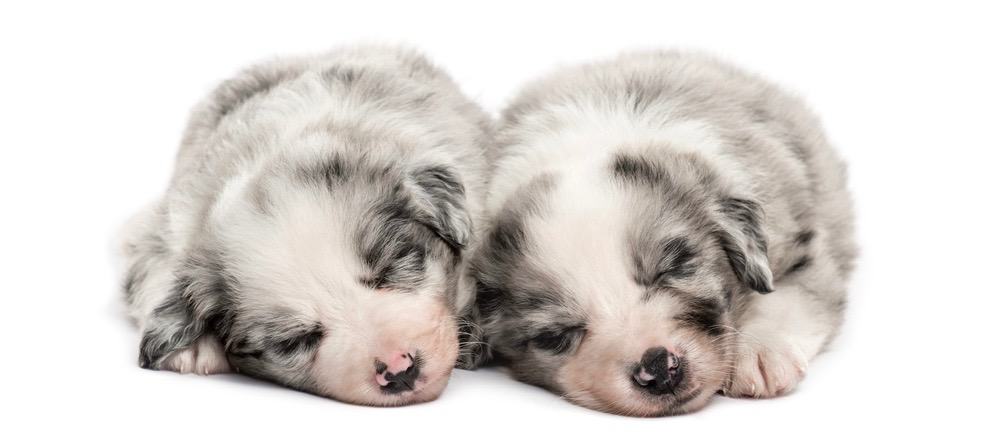
If all else fails you can also consider having a DNA test done. They are many accurate and reliable DNA tests around, and you can use them to measure your Aussiedoodles future weight.
If you are the new owner of an Aussiedoodle, you may likely be wondering when it will stop growing because they tend to grow really quickly from a newborn. Aussiedoodles develop really fast up until the 12-month mark. They will stop growing, once they are 2 years old.
Aussiedoodle Growth Chart – What To Expect
Birth – 2 Weeks
At this time Aussiedoodles are not able to look after themselves when they are born because they are in a delicate state. Nourishment comfort and warmth will come from their mother as they depend on her.
Newborn Aussiedoodles can’t walk yet because their muscles aren’t developed, but they snuggle close to their mother. In order to grow in a healthy way, puppies need this time with their mothers. They need an optimal temperature to live and thrive.
3 Weeks – 12 Weeks
Your Aussiedoodle will go through many changes, at 3-12 weeks as their muscles begin to get stronger. They develop teeth, and they are fully weaned at around 28-30 days old. Most Aussiedoodle moms would start weaning them soon enough on their own.
4 Months – 6 Months
At this time, the Aussiedoodle puppy will undergo teething. At 6 months, the Aussiedoodle male weighs on average between 7 pounds for the smallest dogs and 70 pounds for the largest dogs. The Aussiedoodles females tend to be a bit smaller, at 6 months.
7 Months – 9 Months
At this stage, your Aussiedoodle will enter the heat cycle will last for about 4-8 weeks, and the females are fertile at this time, but it is not advised that she gives birth at this time.
Typically, it is not advised that younger dogs give birth at their first heat cycle because they have not finished their development.
Usually, in this phase, the smaller-sized Aussiedoodles will have reached full-grown size. Nevertheless, a female Aussiedoodles’ body is continually developing and preparing to give birth. Aussiedoodles generally have their first heat when they reach the age of 9 months.
10 Months – 12 Months
During this period, your Aussiedoodle is very active and determined to explore surroundings and learn boundaries. It’s too bad that this is when owners begin to have trouble with their dog’s behavior. This is the best time to instill proper habits into your dog. You will thank yourself later.
Adult
At 2-years-old, the Aussiedoodle male and female will complete their growth. A full-grown Aussiedoodle is usually athletic and loving, with a full curly coat.
Overall, they are well-proportioned and tend to be smart and friendly. Until they are twenty-four months old, many Aussiedoodles will continue to add muscle.
Factors That Affect Aussiedoodle Puppy Growth
Genetics
An Aussiedoodle’s growth is greatly impacted by genetic factors especially because they are crossbreeds of Poodles and Australian Shepherds. These hereditary factors of both parents affect the growth rate.
Additionally, other essential factors, like genetic diseases add to their development. For example, if both parents are large, then the offspring will be also. The fully grown dog will be approximately the average of the parents’ sizes.
Nutrition
All the vitamins and minerals your dog needs to grow larger and stronger can be found in more nutritious food. Your Aussiedoodle puppy’s ability to grow will be affected by the type of nourishment given to him.
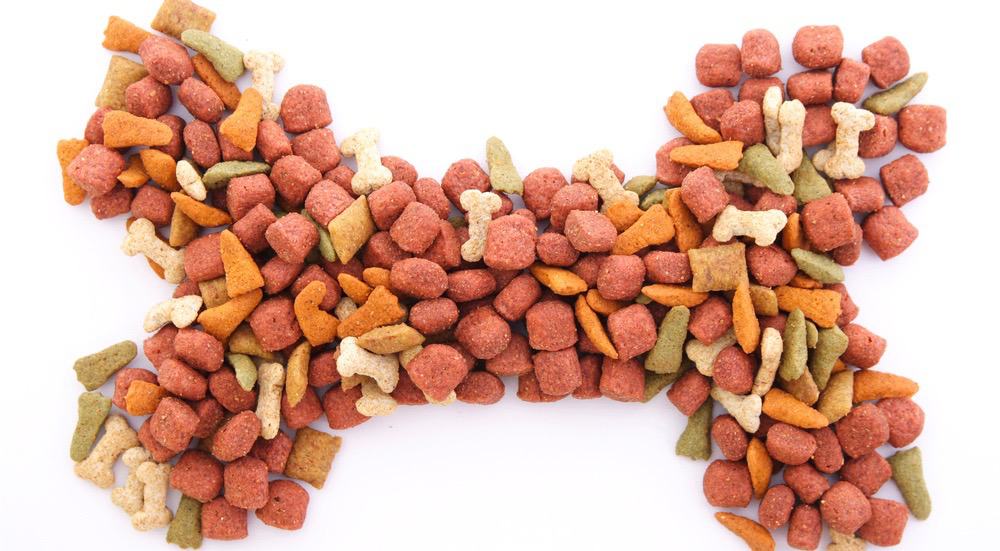
You may also need to give supplements to your Aussiedoodle for the betterment of his health. These are mostly for cases when your dog may be grossly underweight or malnourished and may need additional help to grow to its average height and weight.
Physical Activity & Health
Aussiedoodles were originally bred for jobs that require decision-making, concentration, and intelligence, like herding livestock, and they enjoy time with humans and sufficient exercise, which allows them to meet developmental milestones.
Lots of physical activity is needed to promote growth and allow bone density to be developed. Your Aussiedoodle will have healthy strong muscles when he is involved in regular exercise.
What If My Aussiedoodle Is Not The Right Weight
The weight of your Aussiedoodle is determined by the type of Aussiedoodle you have. They are a fairly new breed and there are size variations that range from toy to standard based on the Poodle parents they have.
So it may be difficult to predict size. You will notice that Aussiepoodles range in size from small to medium because of their mix between Poodle and Australian Shepherd parents.
Of all the Aussiedoodles, most of them, on average weigh in at 25 to 70 pounds and range in height from 10 to 15 inches at the shoulder.
But this is a general guide because many can be smaller and larger. An ideal Aussiedoodle diet should be created for a small to medium-sized breed with high energy and physical activity.
The Aussiedoodle tends to gain weight if they are fed too much, like both of their parent breeds, which is why you need to stick to a regular feeding schedule and not leave food out during the day. If your dog has a weight problem, you should limit his treats as well.
How Many Puppies Do Aussiedoodles Have?
Sizes can affect the number of puppies that an Aussiedoodle can have in a litter.
Miniature Aussiedoodles usually have a smaller amount of pups. The average litter size for the Miniature Aussiedoodle is between 3 and 5 puppies.
Litters tend to be small; however, they can have up to 6 or 7 puppies in certain instances, and this depends on the health of your Aussiedoodle.
Standard Aussiedoodle usually has average litter sizes. For the Standard Aussiedoodle, it is between 5 and 7 puppies. They are known for having a smaller litter of only 2 or 3 puppies, but some may have more.
What Is The Life Expectancy Of An Aussiedoodle?
Aussiedoodles are excellent companions who have a life expectancy of 10 to 12 years.
You may be able to prolong their life by a few years past this mark if you keep your pet fit and mentally stimulated throughout their life-span.
Aussiedoodles are subject to several health risks from either of their parents. These can affect their life expectancy. A 15-year-old Aussiedoodle is not a strange thing, because both Poodles and Australian Shepherds tend to live long lives.
Miniature and toy poodles tend to live longer, as small dogs often live longer. Therefore, if you have a standard Aussiedoodle, you can predict that it will have a slightly shorter lifespan.
How To Choose An Aussiedoodle Size
Because Aussiedoodles are mixed breeds and therefore don’t have purebred standards they have to meet, knowing the final size of the dog can be a bit of a difficult task. Based on your living situation, it may be crucial to get an Aussiedoodle puppy that you can predict his full-grown size.
You need to ask your breeder about the parents of the puppy and how big they are, so you can gauge their size. In this way, you can have a clearer idea of the size of the dog you bring home. The parent’s size is an important indicator of your Aussiedoodle’s future size.
Aussiedoodle Genetics And Common Health Problems
It’s entirely possible that your veterinarian may want to slow down the rate of growth of your Aussiedoodle because they are known for having hip dysplasia. This will stop your Aussiedoodle from becoming big too quickly.
This is more of an issue in larger breed dogs, but it’s still something that may affect your dog, therefore, it might be a discussion you want to have with your vet.
Aussiedoodles may develop health conditions common to both Poodles and Australian Shepherds, especially if you aren’t careful where you buy your puppy. They include cataracts, progressive retinal atrophy, hip dysplasia, autoimmune thyroiditis, epilepsy, and a skin disease called sebaceous adenitis.


